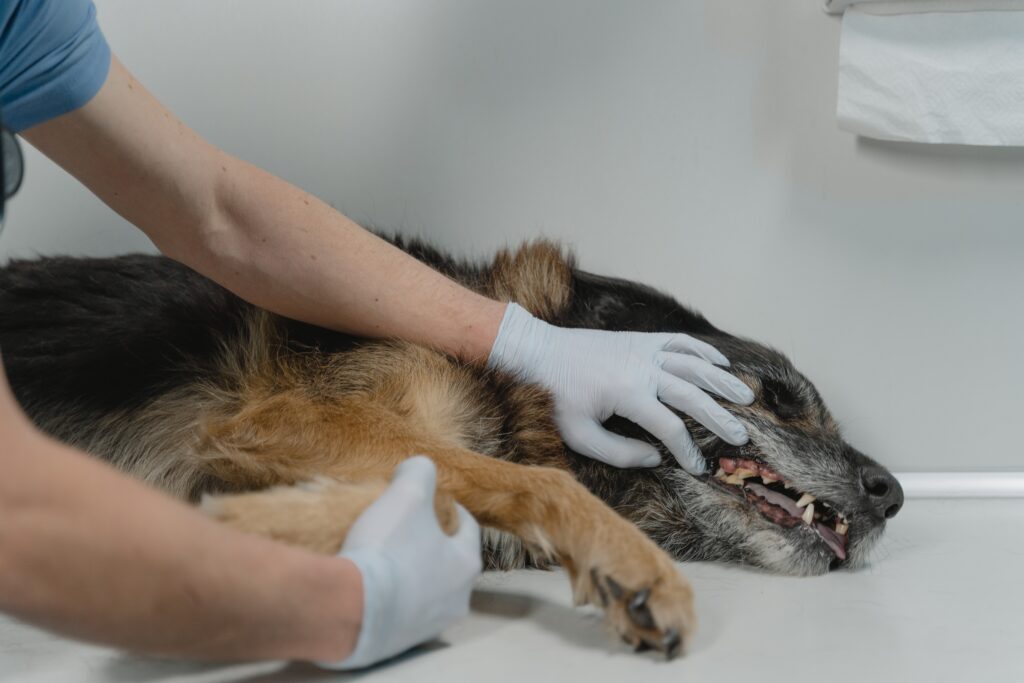Owning a dog is a special experience. They offer companionship and love and have a unique ability to make you smile right when it’s what you needed most.
As a dog owner, you take great pride in making sure that your dog is as healthy and happy as possible. You feed them the best diet and make sure they get every type of vitamin needed for optimal health. Unfortunately, you can’t fully control your dog’s health.
That’s why you need to have an understanding of dog illness symptoms. This article takes a look at the most common dog diseases and how to spot them.
Keep reading to discover insight into how to keep your fur buddy feeling great!
Something Seems Off
One of the keys to staying on top of your dog’s health is to simply pay attention. After all, you’re more familiar with their normal behavior than anyone else.
Watch for signs that something just seems “off”. When you notice behavior that seems out of the ordinary, this is a sign that you probably need to take a closer look.
Unfortunately, your pet has a limited ability to communicate with you. This means they won’t be able to tell you when they aren’t feeling well.
Once you’ve noticed they haven’t been themselves lately, consider making a vet appointment as soon as possible. A sudden change in behavior could be something minor, but it could also be a sign that there’s something far more serious going on that needs to be addressed as soon as possible.
Loss of Appetite
One clear sign of possible illness is a loss of appetite. After all, most doggies love mealtime.
When you notice that your dog is eating less than usual, or has stopped eating altogether, you should definitely be concerned. It could be a sign of something as serious as dogs pancreatitis.
First, check their food. Is it fresh? Many dogs will refuse to eat if there is a problem with the food, so give them something else to see if this makes a difference.
Once you’ve clearly established that your pooch still refuses to eat, make an appointment with their vet right away.
Refuse to Drink Water
The same is true of water. Is your dog suddenly refusing to drink anything? If so, this isn’t good.
Granted, every dog is different. Thus some dogs love to drink a lot of water, while others may only sip a bit throughout the day or when eating. But every dog needs plenty of water, and a refusal to drink should never be ignored.
Always make sure that your dog has fresh water each day, and then pay close attention to their drinking habits. If you notice something is different, don’t hesitate to investigate the situation.
Runny Eyes
Believe it or not, your dog’s eyes can tell you a lot about the state of their health.
This is especially true when a dog develops allergies. When your pet’s eyes are watering or have discharge, this is a clear sign of a problem.
The first action you should take is to clean your house. Vacuum thoroughly and change the filter in your HVAC system. It would also be a good idea to update their current food and make sure they are drinking plenty of water to avoid dehydration.
If the problem persists, take them to the vet as soon as possible just in case the situation turns out to be more serious than you initially suspected.
They’ve Developed a Cough
Coughing isn’t normal behavior for dogs, especially if they’re young.
You might notice that your dog sneezes or coughs during particular seasons of the year, but this shouldn’t happen on a regular basis.
Your vet should be able to identify allergies and prescript any medications that are needed. But if the coughing persists, make sure to notify your vet and tell them exactly what you’ve been observing.
Never ignore coughing, and always keep in mind that it could be a symptom of a more serious health issue that requires immediate medical attention.
Their Coat Looks Dull
A healthy dog should have healthy-looking hair. Healthy hair is shiny and soft, and should never be greasy or dull. And if you happen to notice any bald patches, ask your vet if this is something you should be concerned about.
Lack of Energy
Dogs typically have an abundance of energy. They love to play and explore. So when you notice a sudden lack of activity, there might be a reason for this.
Does your dog’s activity seem more labored than normal? If so, you’d be wise to spend some time loving on her to see how she reacts to your attention.
They’re Scratching More Than Usual
Scratching is another symptom that your dog might not be feeling well. It’s natural for dogs to scratch occasionally, but if they’ve been properly treated for ticks and fleas, any scratching should be kept to a minimum.
If you notice an increase in scratching, look her over, then call your vet if necessary.
They Have Diarrhea
Diarrhea is another sure sign that your dog isn’t feeling well. This could be in conjunction with a lack of activity or loss of appetite, and likely means she needs a visit to the visit as soon as possible.
Keeping to Themselves More Than Usual
And finally, when your dog becomes a bit less social than usual, this could be a sign that she doesn’t feel well. Give her plenty of love and attention, and if she doesn’t perk up, medical care is likely in order.
A Helpful Guide to Dog Illness Symptoms
The ability to quickly identify dog illness symptoms could save your dog from feeling sick longer than necessary. Fortunately, the tips contained here can help you know when it’s time for a trip to the doctor.
Urinating More or Less Frequently
Changes in urine can have a wide range of potential reasons, making diagnosis difficult and necessitating a veterinarian’s knowledge. Affected by any of these conditions, your pet may urinate more frequently or more heavily than usual.
Urinary Tract Infection
Every dog can develop a urinary tract infection, although older dogs and female dogs are more likely to experience one. A compromised immune system or microorganisms are the most frequent causes. Dogs with UTIs may strain or whimper when attempting to pee, try to urinate repeatedly, or have blood in their urine.
Urethral Sphincter Mechanism Incompetence (USMI)
Up to one in five spayed female dogs may get Urethral Sphincter Mechanism Incompetence, which typically appears 2.9 years after the procedure. Reduced estrogen levels seem to affect the bladder’s ability to store pee and its sensitivity, which can lead to urine leaks, especially while the dog is at rest.
Prostate Disease
When they have prostate disorders such as benign prostatic hyperplasia (BPH), prostatitis, or prostate cancer, male dogs may pee more often. By the age of four, BPH will affect around half of intact male canines, however many will not exhibit any symptoms. Prostatitis is a bacterial illness that typically affects intact canines, but prostate cancer is more common in males that have undergone neutering.
Pyometra
During one to two months of the conclusion of a heat cycle, intact female dogs in their middle or senior years are usually affected by pyometra, although young dogs can also have it. If a female dog is not bred, hormonal changes during and after heat cause the uterine lining to thicken, occasionally generating pockets where bacteria may grow and cause pyometra. The signs include excessive drinking and urination as well as a vaginal discharge that is tinged with blood.
Cystitis
Bladder inflammation, or cystitis, can be brought on by a number of illnesses and disorders. Cystitis in dogs is typically brought on by a bacterial infection. Cystitis can also be brought on by bladder polyps, tumors, stones, and anomalies in the anatomy of female dogs. Dogs that have cystitis typically squat, strain, and urinate infrequently.
Kidney or Liver Disease
Due to the disease’s impact on the body’s capacity to rid itself of toxic waste, a dog with kidney disease may urinate a lot. In addition to fluid retention in the belly, dogs with liver illness frequently have increased thirst and urination.
Diabetes
The most typical kind of diabetes in canines is diabetes mellitus. Excessive thirst and increased urination are two signs of this metabolic disease. A deficiency in an antidiuretic hormone causes diabetes insipidus, which is less frequent. Dogs with the condition create enormous amounts of diluted pee, which causes them to consume a lot of water to make up for it.
Bladder Cancer
Urinating infrequently in little amounts, having trouble urinating, and having bloody or colored urine are the most typical signs of canine bladder cancer. Although it is not frequent, bladder cancer is more prevalent in some breeds.
Cushing’s Disease
Hyperadrenocorticism, another name for Cushing’s disease, is typically brought on by a tumor in the pituitary gland. It mainly affects senior dogs, who drink and urinate more frequently than usual as a result.
Imbalance in Urinary pH
A urinary pH imbalance can promote the growth of germs and the formation of crystals or stones in the urinary system. Increased thirst, frequent urination, a pressing need to pee, bloody urine, or inappropriate urination are symptoms. For dogs, the optimal urine pH range is 7.0-7.5. Dietary components may affect a dog’s pH level.
Red of Swollen Gums
Reddened or swollen gums are a sign of gum disease, especially if bad breath is present. When severe, dogs may lose teeth, spit food out, and lose weight from finding it difficult to eat.
Flaking, itchy skin
An excellent overall indication of health is a skin condition. Smooth, black, or pink skin is ideal. Itching that does not go away, blisters, lumps, and dermatitis symptoms might be symptoms of an allergic reaction to flea bites. Fleas are only one of many species of insects that may bite people and induce these kinds of allergies as well as spread various illnesses.
Progressive weight changes
If your dog seems to lose weight gradually over a period of two to four weeks or exhibits a slow but constant weight loss over a longer time frame, you should be worried. Sudden weight gain may be another sign of trouble.
Changes in Personality
Dogs frequently exhibit behavioral changes, such as reduced activity or lethargy, when they are in discomfort or not feeling well. Normal gregarious dogs who are ill may begin to isolate themselves. A friendly and active pet could start becoming snippy or aggressive.
See whether your dog growls when you approach a certain area of its body that it may be experiencing discomfort in. Not all sick dogs will behave badly while they are unwell. Some dogs may start to become more clingy or needy. Some just exhibit regular alterations, which is indicative of canine cognitive impairment.
Keep an eye out for any new symptoms in your dog, such as lameness, a lack of appetite, stomach pain, vomiting, diarrhea, or straining to pee. Contact a qualified veterinarian if you observe any major changes in your dog’s behavior or other symptoms.
Stiffness/Lameness/Difficulty Rising
A fractured bone, arthritis, hip dysplasia, joint issues, infections like Lyme disease, and other conditions can all make it difficult to walk or produce a limp.
Limit your pet’s activity if they are stiff or limping. You might be able to let your dog have a day of rest if the ailment is minor and everything else about their behavior is normal. Consult your veterinarian if you are concerned or if the issue continues.
Keep reading to see more great lifestyle tips and advice.




